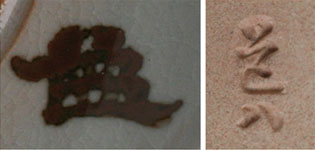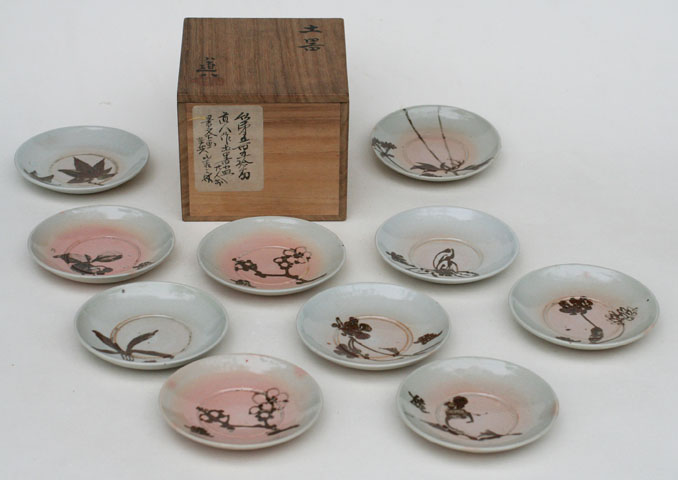Shijô
Set of 10 decorated dishes with floral designs - hana e dozaraSigned: Kaô Keibun
Seals: Dôhachi
Technique: Grey and pink gohonde glazed kyoyaki pottery with a underglaze tetsu-e, iron oxide, floral decoration Ø 9,5 x 1,7
Box: Signed by Keibun and Nin’ami
Condition: fine
Keibun was the younger brother of the painter and poet Matsumura Go Shun (1752-1811). Go Shun was, in fact, 27 years older than Keibun and took care of his education. After Go Shun’s death in 1811, Keibun inherited the studio on Shijô Street. Together with Okamoto Toyohiko (1773-1845), he carried on the Shijô School, Keibun specializing in kachôga and Toyohiko in landscape painting. Keibun was one of Kyoto's leading artists and the teacher of many well-known pupils.
Reference:
Roberts p. 74
Araki p. 2948
Hillier pp. 126-136
Kyoto '98 p. 292
Nin’ami is often referred to as Dōhachi I. However, because his father was likewise active as a potter under that name we also find him designated Dōhachi II. Like his father, Dōhachi was active in Kyoto; he had a kiln at the Nishi Honganji and in the Saga district. He also worked in Takamatsu on the island of Shikoku. Dōhachi studied with Okuda Eisen (1753-1811), who had also been Aoki Mokubei’s teacher. Although he made excellent copies of Chinese and Korean ceramics, he generally favoured Japanese styles. Among his finest works are imitations of Nonomura Ninsei and Ogata Kenzan, and of raku ware. Unlike Mokubei, who often worked for the Chinese-style sencha tea ceremony, Dōhachi is associated with cha no yu. From 1806 he was permitted to conduct official business with the prince-abbot (monzeki) of the Shoren-in temple, which secured his reputation. Along with Mokubei and Eiraku Hozen (1795-1854) he is considered one of the great masters of Kyoto pottery of the late Tokugawa period. (AB)
Reference:
Roberts p. 18
Jenyns 1971 p. 246-247
Jenyns 1965 p. 295-297
Price: SOLD

